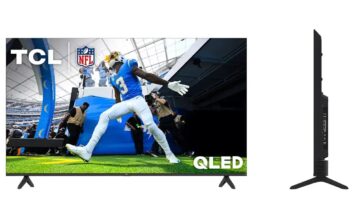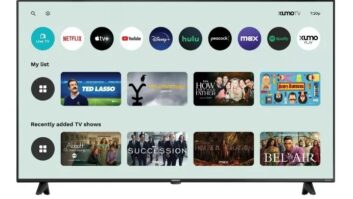NEW YORK — Amazon’s introduction last week of its Fire TV Stick and similarly configured outboard TV settop box continues to build up conduit availability for over-the-top (OTT) services, but industry observers said it also accelerates the inevitable collision course for the two hardware approaches.
Analysts said Amazon introduced the Fire TV Stick just a few months after the original Fire TV adapter settop box in a bid to build its foundation of subscribers to its Prime service, while establishing a portal for all forms of streaming services at the same time.
The mission is an important one, given consumers’ continued attraction with cord cutting and the growing trend toward supplying video- on-demand not tied to traditional subscription packages.
The Amazon Fire TV Stick is a thumb-drive-like streaming- media player targeted at Google’s Chromecast and Roku’s Streaming Stick, among others.
The device carries a $39 everyday retail price, although Prime service subscribers had a two-day window to buy the device for just $19. That’s down from $99 for the original Amazon Fire TV set-top box. The everyday price is just a few dollars more than Google’s Chromecast, but less than Roku’s $50 Streaming Stick.
Amazon’s stick offers more processing power than most of its competitors to drive its advanced feature set, similar to that in its Fire TV box, including voice control (using an optional $29 remote or smartphone app) and the ability to fling content from a smart device to the TV screen.
Purchasers of the Fire TV Stick get a free month of Prime service, which runs $99 a year and includes unlimited free shipping on Amazon purchased goods.
Amazon chief financial officer Tom Szkutak recently told investors the company’s investment in content for its Prime subscription offering is paying off in the form of high subscriber retention rates.
In addition to Chromecast and Roku, Amazon’s new Fire TV Stick is going up against a growing base of smart TVs, offering many of the same benefits without the need of an extra box.
Deirdre Kennedy, Gap and Quixel Research TV market analyst, said the market for both media players, like the Fire TV Stick, and smart TVs continues to grow, with smart TVs making up almost 50 percent of all units sold into the channel, and 60 percent of all TVs placed in brick-and-mortar stores.
Kennedy predicted the numbers continuing to grow over the next few years “until smart TVs become so standard that it will be difficult to find a non-smart model.”
Kennedy noted that the smart-TV growth is tempered somewhat “by the rise of media adapters, which allow consumers to delay new smart TV purchases by adding streaming functionality to existing, older TV models” — an important consideration for cord-cutters looking to trim expenses.
“There are also questions of user experience and content availability that can motivate a consumer to choose one solution over the other,” Kennedy pointed out. “Not all smart TVs are created equal in terms of functionality and ease of use, and the winners in this category will be the smart-TV manufacturers that can provide a seamless experience. Media adapters are popular because they serve one purpose, and they do it well. Smart TVs try to be too many things at once and can often be confusing for the end user.”
According to The NPD Group, U.S. sales of what it called “networked content devices” amounted to $731 million in revenue at retail for the 12 months ending September 2014.
The market-research firm ranked Google (Chromecast), Apple (Apple TV) and Roku as the top unit share leaders in the period.
Ben Arnold, NPD executive director and industry analyst, said, “We are reaching a saturation point, however, as we bring more connected video products into our homes. I think on both sides (smart TVs and network content devices) we will have to see some differentiators to keep consumers interested. Right now, much of the use case revolves around a few key, but omnipresent, services like Netflix, Hulu and Pandora. With these services, we have ubiquitous access across TV, mobile, PC and game devices.”
Arnold said he believes that as consumers begin to see the value in sharing personal content to the big screen from mobile devices through devices like Chromecast and Fire TV Stick, “that will become more central to the use case. I also think there is a big opportunity in gaming on these devices- Amazon and Roku have been the leaders in that as a feature.”
The secret to long-term success, he said, lies in being “the fastest to innovate and add some of these features. I think the ecosystem companies like Google, Apple, Microsoft and now Amazon are best suited to lead the network content device category since one of the drivers to owning one of these devices is having access to one’s library of owned content.”
In a growing number of cases, consumers are opting for both smart TVs and add-on dongles because “the major streaming apps (Netflix, Amazon Instant, Hulu Plus, Apple) are not always found on the same platform, which can prompt consumers to purchase a media adapter even if they already own a smart TV, simply to get the content that they prefer,” Kennedy said.
Ultimately, she added, smart-TV manufacturers have the edge in that the functionality will become a standard spec and make the need for separate media adapters obsolete.
“As non-smart-TV owners begin to replace their current TVs over time, they will more than likely have no choice but to purchase a smart TV,” said Kennedy. “However, if media adapters can create an advantage in terms of ease of use, they will be able to extend their relevance in the marketplace.”
As for market size, NPD In-Stat forecast 100 million homes in North America and Western Europe will own digital media players and television sets that blend traditional programs with Internet content by 2016.
According to IHS, smart-TV shipments will reached 15.5 million units by the end of 2014 representing 44.6 percent of total TV shipments, growing to 18 million and 52 percent of all sets next year.
Meanwhile, Amazon’s Fire TV Stick received the support from some leading physical retailers, including office super store Staples.
Staples spokesman Mark Cautela said, “Staples is committed to offering great selection to our customers and is proud to carry a variety of the hottest technology products on the market.”
The chain is allowing its customers to take advantage of Staples’ ongoing Technology Trade-In option, and get cash back (via a Staples eCash card) when they trade-in a qualifying device, which can be used towards the purchase of a new Amazon Fire TV Stick.
He said Staples has been carrying Amazon’s original Fire TV device in select stores as well, and the chain carries a wide variety of media adapters, including Chromecast, Apple TV and Roku devices.
Staples and Amazon have partnered on other ventures as well in the past. For example, Staples was one of only a few national chains to put Amazon fulfillment lockers in its stores. That program has since been dropped, but Staples continues to sell Amazon Kindle products through in-store end-cap displays.
Staples said that by carrying the Fire TV Stick in physical stores, it gives consumers easy access to see the product first-hand before purchasing.













